Bibliometric Review of Prefabricated and Modular Timber Construction from 1990 to 2023: Evolution, Trends, and Current Challenges
Abstract
:1. Introduction
2. Methodology
2.1. Bibliographic Search
2.2. Scientometric Analysis
3. Results
3.1. Thematic Analysis Conducted by Periods
3.1.1. Subperiod 1990–2004
- Quantitative measures and strategic diagram.
- 2.
- Thematic network
- ThemesThe network graph analysis reveals that the clusters of TIMBER-STRUCTURES and DESIGN (Figure 3) are highly interconnected (in other words, each cluster focuses on a specific topic, and all their keywords are related between them). The first cluster is related to various aspects and components involved in constructing and evaluating timber structures, including steel, fiber-plaster-boards, trusses, walls, experimental-test, fem-analysis, structural-performance, and joints. On the other hand, the second cluster, centered around the efficient performance of structures and design processes, delves into concepts such as resistance, reliability, construction, civil-engineering, behavior, loads, and connections.
- Relationship between themes with most-cited articlesThe collection of keywords provides valuable insights into the research focus during this period. For example, Dobrila and Premrov [34] discussed the importance of the composite timber frame–fiberboard panel wall design. Their study demonstrated that inserting diagonal steel strips attached to the wooden structure represents the most effective method to enhance the resistance and flexibility of the elements. Among the investigations that concentrate on finite element method (FEM) analysis in timber structures, the work of [35] stood out due to its introduction of an analytical technique for examining the behavior of light-frame wood structures when subjected to static loads. The study primarily focused on the behavior of substructures and system components that have not been previously included in a comprehensive structural model. The findings indicate remarkable similarities between the experimental and analytical outcomes. Similarly, Tarabiate and Itani [36] described a three-dimensional computer model for evaluating light-frame wood constructions. Their study showcased the model’s capability to explore various structural configurations and generate design requirements for wood structures.
3.1.2. Subperiod 2005–2019
- Quantitative measures and strategic diagram.
- 2.
- Thematic network
- Motor themesAnalyzing the network graph (Figure 5a), it can be observed that the principal motor theme, CONNECTIONS, forms a highly interconnected cluster that explores various structure-related aspects. These aspects include timber-structures, behavior, experimental-tests, and structural elements such as beams. It is also linked to engineered timber materials like clt and the combination of timber with other materials, such as hybrid and composites. It is worth noting that during this period, certain studies assessed the performance of connectors in prefabricated timber-framed walls [37] or prefabricated timber composite systems [38].Moving on to the second motor theme, LYFE-CYCLE (Figure 5b), this cluster covers many aspects related to the Life Cycle Assessment (LCA) methodology, such as energy-performance, environmental-impact, emissions, carbon, impacts, and climate. Additionally, it includes other terms associated with construction processes, such as civil-engineering and production-planning. However, it is essential to note that despite being a motor theme, it does not have an extensive collection of published articles. This can be attributed to the lack of specific rules governing the LCA of whole buildings and wooden building products before 2011. Consequently, this led to a vast dissimilarity in approaches, results, and interpretations among various studies, as highlighted by [39]. For instance, the study conducted by [40] emphasizes prefabricated techniques, specifically wood-frame systems, as an alternative approach to reducing a building’s carbon footprint.
- Highly developed and isolated themesIn the second quadrant, the theme NUMERICAL-MODELING (Figure 6a) delves into various aspects related to the seismic behavior of structures. These aspects include analysis, seismic-performance, cyclic-testing, materials, and structural elements such as steel, timber-framed-walls, and timber-shear-walls. Furthermore, this theme considers components in the design of facades, such as openings and sheating. The research undertaken by [41] investigated a hybrid structural system comprising a steel moment-resisting frame and prefabricated infill light-frame timber shearwalls. The author stated that quasi-static cyclic and monotonic loading tests were carried out to analyze such structures’ seismic performance accurately, and the results were evaluated using a numerical model.HYGROTHERMAL-PERFORMANCE (Figure 6b) focuses on factors leading to potential issues, such as mold and moisture. It covers the parameter measurement of insulation performance such as u-values, evaluation forms such as simulations, construction elements such as assemblies, and construction elements such as highly-insulated-wood-frame-walls. Also, it is related to other factors that impact hygrothermal performance, such as air-leakage and risks. Moving forward, THERMAL-PERFORMANCE (Figure 6c) is linked to energy transfer aspects, such as heat, materials, and construction typologies, such as insulation, phase-change-materials, systems, prefabricated, and residential-buildings, and processes such as retrofitting. Additionally, it includes other keywords, such as interviews. As the demand for energy-efficient buildings continues to rise, an urgent need is to improve building envelope insulation [42]. Glass et al. [43] focused on analyzing the moisture characteristics of highly insulated wood-frame walls in mixed-humid climates. The authors of [44] employed hygrothermal simulations and field measurements to analyze the moisture content in the surface layers of cross-laminated timber (CLT) panels. Other studies have attempted to optimize the structural and thermal performance of light wood-frame structures to enhance thermal efficiency and structural capacity [45].
- Emerging or declining themesThe theme WALLS (Figure 7) focused on structural forces, characteristics that influence the behavior of structures, and methodologies employed to measure them, such as loads, ductility, failures, full-scale-tests, and nonlinear. It also includes architectural typologies and structural elements, such as buildings, frames, and timber-framed-structures. For instance, Van De Lindt et al. [46] focused on examining the damage incurred by lateral load-carrying assemblies within wood frame structures, specifically shearwalls. The researchers also explored the potential for developing a holistic predictive damage model for the entire structure and integrating it into seismic design practices.
- Basic and transversal themesAmong the themes that hold significant relevance to the field but have not yet been extensively explored, we found the theme MODELING (Figure 8a), which was linked to various aspects of timber structures, encompassing structural-performance, design, strength, and fire-behavior; different types of timber structures, like light-frame-structures; and structural support elements, such as shear-walls. It was also associated with hurricanes and wind. The authors of [47] presented a three-dimensional model of a two-story house design utilizing a prefabricated timber-frame structural system. Using parametric analysis, the study offered a single-variable parameter to find the suitable glazing area size value for all modern prefabricated timber buildings.INDUSTRIALIZED-CONSTRUCTION (Figure 8b) is a highly interconnected cluster that incorporates various topics related to the construction process and structural design, such as modular-construction, timber-construction, innovation, shrinkage, and performances, as well as the structural components of buildings, such as floors and concrete-composite-structures. Novel modular structures that could facilitate the rapid fabrication of new residential complexes were proposed in this period. As demonstrated by [48], a versatile construction system in which the prominent structural members, made by combining steel–timber hybrid shearwall and floor components, present a low environmental impact, given their recyclability and quick replaceability. Similarly, [49] proposed an innovative composite steel–timber prefabricated floor component that showcased the system’s potential in bearing capacity, stiffness, and construction methods.Finally, the theme CONCRETE (Figure 8c) primarily focuses on exploring structural timber elements, such as mass-timber and timber-concrete-composite-structures. Furthermore, it mainly delves into materials that bond these elements, including adhesives and gluing. It also covers structural topics like shear, balances, and reinforcement, and numerical methods like fem-analysis. To illustrate this point, some researchers have dedicated their efforts to conducting experimental tests that examine the structural performance of prefabricated timber–concrete composite floors [50,51].
- Relationship between motor and basic themes with most cited articlesIn this period, numerous investigations persisted to determine the structural behavior of light-framed prefabricated timber buildings [52,53,54,55]. Nonetheless, the comprehensive examination of the structural performance of mass timber construction methods has not been fully addressed. Among the most crucial aspects of the design process in mass timber structures lies the design of connections, as they impact the joining of members and the load capacity, stiffness, and ductility of the entire system [56].Regarding the most frequently mentioned subjects (related to the motor or fundamental themes and their networks), a noteworthy instance of connections and their strong relationship with CLT was the complete-scale seven-story framework composed of CLT panels following the European seismic standard Eurocode 8. It was subjected to earthquake-induced loading on a three-dimensional shaking table. The seven-story structure was part of the research project “SOFIE-Sistema Costruttivo Fiemme”, whose goal was to exhibit the capability to self-center, possess high stiffness, and possess sufficient flexibility to avert brittle failures. Additionally, tensile joint assemblies were developed, and their importance in dissipating energy in structures with rigid CLT panels became apparent. Lastly, the authors noted that the seven-story structure experienced relatively strong accelerations at higher levels, which could result in secondary damage and should be addressed in future investigations [57]. Another approach to the same topic was the work of [58]. The study examined alternative mechanical “dry-dry” connections previously integrated into a prefabricated concrete slab. Direct shear tests were conducted on small blocks constructed from glulam segments affixed to a prefabricated concrete slab. The experiment measured the relationships between shear force and relative slip and calculated mechanical properties, such as slip moduli and shear strengths. The findings indicated that innovative connection technologies for precast concrete slabs can perform comparably to cast-in situ slabs while being more cost-effective.Lastly, one of the most frequently addressed topics was the energy efficiency of timber buildings. The authors of [59] utilized a consequential-based lifecycle approach to examine the carbon implications of conventional (Swedish building regulations) and low-energy (Swedish passive home standards) versions of three timber multi-story building systems. The building systems were constructed using mass timber (CLT components), beam-and-column structures (glulam and LVL components), and prefabricated modules of light-frame volume elements. The analysis encompassed the entire resource chain throughout the lifecycle of the building, tracking carbon flows from fossil energy, industrial processes, changes in carbon stocks in materials, and potential avoidance of fossil emissions through the substitution of fossil energy with woody residues. In conclusion, the study emphasized the potentially significant role of multi-story timber structures in carbon-efficient construction by demonstrating that the low-energy variant of the CLT building emits the least amount of carbon over its lifespan. In comparison, the standard beam-and-column construction exhibits the highest lifespan emission.
3.1.3. Subperiod 2020–2023
- Quantitative measures and strategic diagram.CONNECTION emerged as the dominant motor theme (Figure 9). It accumulated the highest number of citations, totaling 518, and had the most significant number of published documents, reaching 80. However, it had a relatively low impact on the field of research, as indicated by its h-index score of 12. The following motor theme was ENERGY-PERFORMANCE, which ranked third in the number of citations with a count of 183. However, the number of published papers was comparatively low (36), resulting in a correspondingly low h-index score of 9. Additionally, within the first quadrant of the strategic diagram, other motor themes emerged: CIRCULAR-ECONOMY and COMPOSITES. The former had a number citation count of 127, while the latter had 123 citations. Both themes shared the same number of publications, 16, and achieved an h-index score of 7, as can be seen in Table 5.Moving on to the second quadrant, the highly developed and isolated theme was BUILDING-ENVELOPE. This theme was characterized by 19 published documents, 127 citations, and an h-index score of 8. In the third quadrant, we observed emerging or disappearing themes such as FLOORS, MODELING, and SEISMIC-PERFORMANCE. FLOORS was represented by 14 published documents and achieved 84 citations. The h-index score was the lowest among all the themes analyzed, standing at 5. On the other hand, MODELING and SEISMIC-PERFORMANCE boasted citation counts of 98 and 74, respectively. The h-index score for MODELING was 5, while for SEISMIC-PERFORMANCE, it was 7. Finally, the fourth quadrant was occupied by the basic and transversal theme, CONSTRUCTION. This theme ranked second in the number of citations, with a count of 232. It was accompanied by 32 published documents and an h-index score of 8.Upon comparing this subperiod to the previous one, the number of themes remained relatively consistent. However, there was a noticeable increase in the quantity of motor themes within the quadrant. Additionally, the number of published documents in this subperiod, totaling 200, was almost on par with the previous subperiod. Similarly, we found that the motor themes (first quadrant) and basic themes (fourth quadrant) continued to be the most highly cited and were associated with the highest number of documents. It is worth noting that the analysis only covered three years, yet it was evident that researchers have shown a growing interest in the motor and basic themes.
- Thematic network
- Motor themes
As illustrated in the thematic networks, the motor themes CONNECTIONS (Figure 10a) and ENERGY-PERFORMANCE (Figure 10b) are closely connected clusters (each cluster is focused on a specific topic). The first motor theme is mainly focused on the conditions of structures under loading and construction materials, which include structural-performance, experimental-tests, shear, performances, behavior, clt, and timber-concrete-composite-structures. Additionally, this cluster incorporates analytical models such as fem-analysis. On the other hand, the second motor theme is associated with crucial measures for assessing the sustainability of a structure, including life-cycle, environmental-performance, thermal-performance, carbon, and heat. In addition, it contains structural and construction topics such as residential-buildings, timber-structures, and blast. Although CLT is now being utilized for previously considered improbable structures, the technology for connecting these elements is still evolving [60], and it is discussed in various papers published during this period [61,62]. Furthermore, there is a specific focus on enhancing the energy dissipation capacities of mass timber building assemblies by utilizing steel energy-absorbing connections [63].Another motor theme that exhibits significant connectivity is CIRCULAR-ECONOMY (Figure 10c), which delves into construction and structural concepts, including architecture, design-for-disassembly, business-models, systems, challenges, and buildings. It also covers construction materials such as mass-timber and concrete. The circular economy concept is extensively discussed in the publication by [64], which presents a systematic literature review highlighting significant knowledge gaps and urgent research needs for developing holistic approaches to circularity potentials for panelized mass timber structures.In contrast to the previous ones, the theme COMPOSITES (Figure 10d) does not possess a well-connected cluster. This theme focuses on the structural behavior of the structures, construction elements, and materials such as loads, collapse, strength, resistance, part-I, validation, beams, and steel. In the scope of composites, several investigations concentrate on the structural behavior of prefabricated timber-concrete composite elements with innovative connections [65,66].- Highly developed and isolated themesThe theme BUILDING-ENVELOPE (Figure 11) is related to the external behavior and properties of the building’s envelope. This covers various aspects, such as hydrothermal-performance and airtightness. Moreover, it covers construction elements, potential issues, and the materials utilized in the building envelope, such as wood-frame-walls, walls, mold, moisture, air-barrier, and oriented-strandboard. Research efforts have been ongoing to study timber-framed and mass-timber external wall assemblies, as timber proves to be effective in reducing thermal bridges due to its low thermal conductivity, which enhances a building envelope’s overall energy efficiency [67]. For instance, [68] demonstrated the correlation between the hygrothermal simulation tool (WUFI) model output and the measured values of OSB moisture content (MC), cavity temperature (T), and cavity relative humidity (RH) for wood-framed walls with various exterior insulations in cold climates.
- Emerging or declining themesFLOORS (Figure 12a) covers structural material properties and processes to improve the structural material properties such as flexural-behavior and prestress, and types of connections including shear-connections, joints, and screws. It also covers the parts and features of the structures, including elements and prefabricated. The analysis presented by [69] shed light on the acoustic performance of timber buildings and complex composite floor systems in the Australian construction industry. The study indicated that prefabricated construction methods showcased improved performance compared to on-site construction. However, direct comparisons are challenging due to the varying timber products and construction techniques. Thus, establishing well-defined measurement methods, predictive models for sound insulation properties, and numerical simulations for airborne and impact sound transmission becomes imperative.The theme MODELING (Figure 12b) focuses on the structural behavior of systems, structural elements, and the evaluation of processes. This includes fragility, failures, post-tensioned, stiffened-engineered-timber-wall-systems, timber-framed-structures, and damage-assessment. In addition, it covers technology types and visual media such as digital-design and virtual-design. For example, Wei et al. [70] proposed implementing a Digital Twin model, a collection of technologies to establish seamless physical and virtual connections. This model was designed to enhance the productivity of a wood-panel construction company. The company could foresee significant waste reduction and improve overall efficiency by utilizing this model. Additionally, it facilitates the widespread application of technology by providing a holistic framework.SEISMIC-PERFORMANCE (Figure 12c) is related to the seismic characteristics and evaluations of the behavior of a structure, covering various factors such as ductility, lateral-performance, damage-free, and analysis. Also, it includes types of connections, dowel, and construction systems, such as frames. In the study conducted by [71], the focus was on the redesign of a nine-story residential building constructed with reinforced concrete (RC) using a hybrid disassembly building approach involving cross-laminated timber floors, glue-laminated timber frames, and concentrically braced steel frames. This research shed light on the fact that although the lateral load capacity of the hybrid building is lower than that of the RC building, its deformation capacity is significantly higher. Moreover, the LCA results indicated that the carbon emissions from the RC building were twice as much as those emitted by the hybrid building. Therefore, material selection and construction technologies are critical for implementing circular projects in seismically active areas.
- Basic and transversal themesCONSTRUCTION (Figure 13), a relevant theme in the field, presents a highly interconnected cluster. It mainly focuses on structural processes, including design, management, manufacturing, climate, opportunities, and production-planning. It also covers the application of technology to improve them, such as automation and industrialized-construction. Understanding the multitude of variables that influence the adoption of prefabricated timber construction enhances the implementation of the construction industrialization process. In their study, Du et al. [72] examined modern timber structures (MTSs) in China from the stakeholders’ perspective. This analysis encompassed critical elements, including government policy, public awareness and acceptability, cost considerations, and the connections between designers, prefabricated component producers, and construction companies. Finally, the research provided recommendations to enhance existing perceptions, bridge the knowledge gap, and accelerate current development efforts to expand the prefabricated timber construction or MTS building sector.
- Relationship between motor and basic themes with most cited articlesAs shown below, the motor and basic themes’ networks are the predominant subjects of reference in the publications developed in this subperiod. It is highlighted that there is a growing interest in automation in timber manufacturing with advancements in digital fabrication technology (e.g., robotic timber manufacturing). This interest stems from the potential for the fully automated production of non-standard timber structures [73] and prefabricated timber buildings. A pioneering approach to robotic manufacturing within the construction industry was introduced by developing, designing, and testing a large-scale, portable, and adaptable automated wood construction platform called TIM [74]. This mechanical system can be swiftly incorporated into existing manufacturing setups in standard carpentry projects, thereby facilitating the exploitation of synergies between traditional craftsmanship and specialized automation technology. As a result, the quality and productivity of the trade can be significantly enhanced. Additionally, the study underscored an interdisciplinary co-design approach that emphasizes cyber-physical design and production methods for multi-story timber buildings. The researchers emphasized the need to address several significant challenges in future studies before the widespread adoption of robotic timber-building platforms can be realized in the industry.Considering the current focus on energy performance and the circular economy, Margani et al. [75] proposed an innovative solution for rehabilitating reinforced concrete (RC)-framed buildings considering energy, seismic, and architectural factors. This solution involves the utilization of prefabricated cross-laminated timber (CLT) panels in conjunction with wood-framed panels on the exterior walls. The combination of these panels incorporates insulation and cladding materials, enhancing the energy performance and aesthetics of the renovated building. Furthermore, innovative seismic energy dissipation devices connect the CLT panels to the existing RC frame, reducing structural damage and repair costs during seismic events. In conclusion, retrofitting significantly enhances the energy performance of multi-story residential buildings in Italy, resulting in a reduction of up to 60% in global energy demand.Projections indicate that global demand for mass timber will continue rising upward, particularly in Australia, Japan, and New Zealand [76]. Responding to this trend, Li et al. [77] studied the out-of-plane bending behavior of Radiata Pine XLam CLT panels subjected to four-point loading. The experiments revealed brittle failure modes when the samples were loaded along the central and minor axes. Various analytical approaches were employed to evaluate the bending characteristics of the test materials, with the shear analogy proving to be the most accurate predictor. Other theoretical techniques yielded satisfactory results in determining effective bending stiffness and bending and shear strengths. The bending characteristics of CLT were further assessed through finite element analysis, with the thickness of the panels being quantitatively evaluated concerning their influence on bending behavior. The authors concluded that further parametric analysis was required to comprehensively understand these effects and providing data support for future practical applications.
3.2. Thematic Conceptual Evolution
- The themes TIMBER-STRUCTURES and DESIGN (undefined themes) evolve into motor, basic, highly developed, and emerging or disappearing themes in the second subperiod.
- TIMBER-STRUCTURES and DESIGN are the origins of the theme CONNECTIONS, a motor theme in the second and third subperiods.
- Two thematic areas consist of motor or basic themes throughout all the subperiods:
- LYFE-CYCLE (motor theme) evolves into ENERGY-PERFORMANCE (motor theme) and CONSTRUCTION (basic theme).
- CONCRETE (basic theme) evolves into CIRCULAR-ECONOMY (motor theme).
- Only one thematic area comprises a highly developed theme in all the subperiods: HYGROTHERMAL-PERFORMANCE evolves into BUILDING-ENVELOPE.
- Four thematic areas consist of motor or basic themes and an emerging or disappearing theme:
- CONNECTIONS (motor theme) evolves into CONNECTIONS (motor theme), ENERGY-PERFORMANCE (motor theme), COMPOSITES (motor theme), and FLOORS (emerging or disappearing theme).
- NUMERICAL-MODELING (motor theme) evolves into SEISMIC-PERFORMANCE (emerging or disappearing theme) and COMPOSITES (motor theme).
- INDUSTRIALIZED-CONSTRUCTION (basic theme) evolves into CONSTRUCTION (basic theme) and FLOORS (emerging or disappearing theme).
- MODELING (basic theme) evolves into MODELING (emerging or disappearing theme), COMPOSITES (motor theme), CONSTRUCTION (basic theme), and CONNECTIONS (motor theme).
- Only one thematic area comprises a highly developed theme, two motor themes, and an emerging or disappearing theme: THERMAL-PERFORMANCE (highly developed theme) evolves into ENERGY-PERFORMANCE (motor theme), CIRCULAR-ECONOMY (motor theme), and FLOORS (emerging or disappearing theme).
- Only one thematic area consists of three emerging or disappearing themes and two motor themes: WALLS (emerging or disappearing theme) evolves into BUILDING-ENVELOPE (highly developed theme), COMPOSITES (motor theme), CIRCULAR-ECONOMY (motor theme), MODELING (emerging or disappearing theme), and SEISMIC PERFORMANCE (emerging or disappearing theme).
4. Analytical Description by Subperiod
4.1. Superiod 1990–2004
4.2. Superiod 2005–2019
4.3. Superiod 2020–2023
5. Conclusions
- Circular economy. Researchers have shifted their focus towards the reusability and efficiency of prefabricated elements. Prefabricated timber construction is characterized by utilizing large-format building elements and the associated logic of joining them together [16]. This characteristic makes it suitable for disassembly, reuse, and recycling. Therefore, adopting strategies and measures that reduce the carbon footprint, minimize waste, and increase the life cycle of structures aligns with the principles of circular construction. To this end, various initiatives have been developed, exemplified by the MAI-Ivalsa Modular House. This environmentally sustainable system of prefabricated housing modules employs reused CLT for the load-bearing structure, allowing for the prefabrication of components at one site and their successful transportation to another [81]. Another example is the Collegium Academicum IBA, the first multi-story modular timber student residence that offers significant spatial flexibility through simple modular pieces that can be easily disassembled and recycled [82,83]. Additionally, a ten-square-meter prototype utilizing a fully modular precast lightweight engineered timber structural system, as developed by [84], has demonstrated the potential of building-scale additive manufacturing with cost-effective materials to enable deconstruction and material recovery. Studies focusing on hybrid structures have recently begun incorporating assessment strategies such as design for disassembly or deconstruction (DfD). For instance, Grüter et al. [85] presented two case studies of modern residential timber hybrid buildings in Switzerland, employing digital tools to evaluate strategies that facilitate a circular design process for timber elements. These strategies specifically address the elements’ start and end of life, thus serving as a solid foundation for future research. Similarly, Derikvand and Fink [86] proposed directions for future developments and advocated for DfD in timber–concrete composite (TCC) floors, emphasizing deconstructable connectors that enable material recovery and reuse as the preferred end-of-life scenario. These projects underscore the importance of integrating sustainable practices into the design and construction processes. Despite the recent release of a standard by the International Organization for Standardization (ISO), which provides general rules for integrating design for disassembly and adaptability (principles of circular economy) into the service life of structures [87], few studies have, thus far, presented innovative solutions and designed buildings that fully address these strategies. From the literature content analysis focusing on connections and building envelope systems (as was established before, they are critical elements in the design and construction of prefabricated and modular timber structures), only one study stands out as it introduced a novel reversible mass timber connector for prefabricated systems [88] while another explored the design and construction of fully prefabricated façade components to reduce materials and production energy [89].
- Digital technologies. Digital architecture, computer science, engineering informatics, virtual reality (VR), and building information modeling (BIM) are critical in prefabricated and modular timber construction. Integrating these parameters into industrialized construction practices necessitates the implementation of automation in timber manufacturing. For instance, in Canada, there is a strong focus on integrating BIM information into the construction phase, specifically in the context of automated fabrication. A study by [90] delved into a BIM-based framework that aims to automate the machine capability evaluation of timber frame assemblies. This proposal highlights the system’s ability to accurately determine whether a user-selected machine can effectively manufacture a construction product that has been pre-designed using BIM software. In the United Kingdom, the research developed by [91] adopted BIM models in the game environment (gamification) to facilitate the implementation of small- and medium-sized architectural and construction practices dedicated to visualization creation. The collected evidence showcases that combining a game-like platform and BIM can lead to simplified data delivery to clients, ultimately resulting in customer satisfaction, confidence, and increased sales of timber frame houses. According to [92], “the level of automation is high in the initial stages of prefabrication but relatively low in the assembly stages, which require flexibility and human knowledge.” To address this, some research groups are focused on developing robotic systems. Robotic fabrication, directly connected to a precisely planned virtual model, significantly reduces the risk of construction mistakes and ensures high global precision. This results in a cost-effective and efficient construction system [93]. The literature reveals that robotic systems have enabled the construction of unconventional structures, such as the BUGA Wood Pavilion. Furthermore, companies like Weinmann and Randek have gained recognition for adopting these technologies in their processes [94]. Similarly, researchers in the United States have devised a simulation-based methodology to evaluate the automated assembly of wood frames through BIM, utilizing various robotic systems [95]. By employing simulation techniques, researchers can assess the effectiveness of different robotic systems in automating the assembly of timber frames.
- Reevaluating the regulatory framework is necessary to encourage research collaborations between countries, facilitating the transfer of specialized technology knowledge to the labor market.
- Open new research areas in the construction sector, contributing to the growth of existing scientific systems and advancing these fields.
- Implementing professional training programs in industries can promote competitiveness and employment opportunities.
- Integrating timber expertise, including designers, producers, and construction companies, at different stages of the construction process can further enhance the adoption of prefabricated and modular timber construction.
- Raising society’s awareness and knowledge transfer of timber’s potential, such as its safety, cost-effectiveness, adequate structural performance, and environmental aspects, can foster the acceptance of these technologies.
Author Contributions
Funding
Institutional Review Board Statement
Informed Consent Statement
Data Availability Statement
Acknowledgments
Conflicts of Interest
References
- Smith, R. Prefab Architecture: A Guide to Modular Design and Construction; John Wiley & Sons, Inc.: Hoboken, NJ, USA, 2010; Available online: https://ia801906.us.archive.org/23/items/Prefab_Architecture_A_Guide_to_Modular_Design_and_Construction_R._Smith_Wiley_20/Prefab_Architecture_A_Guide_to_Modular_Design_and_Construction_R._Smith_Wiley_2010_BBS.pdf (accessed on 10 December 2023).
- Kamali, M.; Hewage, K. Development of performance criteria for sustainability evaluation of modular versus conventional construction methods. J. Clean. Prod. 2017, 142, 3592–3606. [Google Scholar] [CrossRef]
- Hořínková, D. Advantages and Disadvantages of Modular Construction, including Environmental Impacts. IOP Conf. Ser. Mater. Sci. Eng. 2021, 1203, 032002. [Google Scholar] [CrossRef]
- Boafo, F.E.; Kim, J.H.; Kim, J.T. Performance of modular prefabricated architecture: Case study-based review and future pathways. Sustainability 2016, 8, 558. [Google Scholar] [CrossRef]
- Iacovidou, E.; Purnell, P.; Tsavdaridis, K.D.; Poologanathan, K. Digitally enabled modular construction for promoting modular components reuse: A UK view. J. Build. Eng. 2021, 42, 102820. [Google Scholar] [CrossRef]
- Gunawardena, T.; Mendis, P. Prefabricated Building Systems—Design and Construction. Encyclopedia 2022, 2, 70–95. [Google Scholar] [CrossRef]
- Thai, H.T.; Ngo, T.; Uy, B. A review on modular construction for high-rise buildings. Structures 2020, 28, 1265–1290. [Google Scholar] [CrossRef]
- Abdelmageed, S.; Zayed, T. A study of literature in modular integrated construction—Critical review and future directions. J. Clean. Prod. 2020, 277, 124044. [Google Scholar] [CrossRef]
- Schnell, P. Correlation between modular construction and sustainability in the building life cycle. E3S Web Conf. EDP Sci. 2022, 349, 04006. [Google Scholar] [CrossRef]
- Bertram, N.; Fuchs, S.; Mischke, J.; Palter, R.; Strube, G.; Woetzel, J. Modular construction: From Projects to Products. 2019. Available online: https://www.mckinsey.com/~/media/mckinsey/business%20functions/operations/our%20insights/modular%20construction%20from%20projects%20to%20products%20new/modular-construction-from-projects-to-products-full-report-new.pdf (accessed on 31 October 2023).
- Brege, S.; Stehn, L.; Nord, T. Business models in industrialized building of multi-storey houses. Constr. Manag. Econ. 2014, 32, 208–226. [Google Scholar] [CrossRef]
- Ferdous, W.; Bai, Y.; Ngo, T.D.; Manalo, A.; Mendis, P. New advancements, challenges and opportunities of multi-storey modular buildings—A state-of-the-art review. Eng. Struct. 2019, 183, 883–893. [Google Scholar] [CrossRef]
- Palma, P.; Fink, G. Design for Robustness, Adaptability, Disassembly and Reuse, and Repairability of Taller Timber Buildings: A State of the Art Report, COST Action CA 20139 Holistic Design of Taller Timber Buildings (HELEN). 2022; Available online: https://cahelen.eu/wp-content/uploads/2022/12/CA20139_STAR_WG1.pdf (accessed on 3 May 2023).
- Lattke, F.; Lehmann, S. Multistorey residential timber construction: Current developments in Europe. J. Green Build. 2023, 2, 119–129. Available online: https://meridian.allenpress.com/jgb/article/2/1/119/200068/Multi-Storey-Residential-Timber-Construction (accessed on 27 April 2023). [CrossRef]
- Carvalho, L.F.; Jorge, L.F.C.; Jerónimo, R. Plug-and-Play Multistory Mass Timber Buildings: Achievements and Potentials. J. Archit. Eng. 2020, 26, 04020011. [Google Scholar] [CrossRef]
- Schuster, S.; Geier, S. CircularWOOD—Towards Circularity in Timber Construction in the German Context. IOP Conf. Ser. Earth Env. Sci. Inst. Phys. 2022, 1078, 012030. [Google Scholar] [CrossRef]
- Ramage, M.; Burridge, H.; Busse-Wicher, M.; Fereday, G.; Reynolds, T.; Shah, D.; Wu, G.; Yu, L.; Fleming, P.; Densley-Tingley, D.; et al. The wood from the trees: The use of timber in construction. Renew. Sustain. Energy Rev. 2017, 68, 333–359. [Google Scholar] [CrossRef]
- Li, C.Z.; Li, S.; Li, X.; Wu, H.; Xiao, B.; Tam, V.W.Y.; Asiedu-Kwakyewa, C. A Scientometric Review of Management of Prefabricated Construction from 2011–2021. Buildings 2022, 12, 1515. [Google Scholar] [CrossRef]
- Koppelhuber, J.; Bauer, B.; Wall, J.; Heck, D. Industrialized Timber Building Systems for an Increased Market Share—A Holistic Approach Targeting Construction Management and Building Economics. Procedia Eng. 2017, 171, 333–340. [Google Scholar] [CrossRef]
- Duncheva, T.; Bradley, F.F. Multifaceted Productivity Comparison of Off-Site Timber Manufacturing Strategies in Mainland Europe and the United Kingdom. J. Constr. Eng. Manag. 2019, 145, 04019043. [Google Scholar] [CrossRef]
- Aghasizadeh, S.; Tabadkani, A.; Hajirasouli, A.; Banihashemi, S. Environmental and economic performance of prefabricated construction: A review. Env. Impact Assess. Rev. 2022, 97, 106897. [Google Scholar] [CrossRef]
- Bhandari, S.; Riggio, M.; Jahedi, S.; Fischer, E.C.; Muszynski, L.; Luo, Z. A review of modular cross laminated timber construction: Implications for temporary housing in seismic areas. J. Build. Eng. 2023, 63, 105485. [Google Scholar] [CrossRef]
- Hou, L.; Tan, Y.; Luo, W.; Xu, S.; Mao, C.; Moon, S. Towards a more extensive application of off-site construction: A technological review. Int. J. Constr. Manag. 2022, 22, 2154–2165. [Google Scholar] [CrossRef]
- Liu, W.; Zhang, H.; Wang, Q.; Hua, T.; Xue, H. A Review and Scientometric Analysis of Global Research on Prefabricated Buildings. Adv. Civ. Eng. 2021, 2021, 8869315. [Google Scholar] [CrossRef]
- Yin, X.; Liu, H.; Chen, Y.; Al-Hussein, M. Building information modelling for off-site construction: Review and future directions. Autom. Constr. 2019, 101, 72–91. [Google Scholar] [CrossRef]
- Ecarnot, F.; Seronde, M.F.; Chopard, R.; Schiele, F.; Meneveau, N. Writing a scientific article: A step-by-step guide for beginners. Eur. Geriatr. Med. 2015, 6, 573–579. [Google Scholar] [CrossRef]
- Gurunathan, T.; Mohanty, S.; Nayak, S.K. A review of the recent developments in biocomposites based on natural fibres and their application perspectives. Compos. Part A Appl. Sci. Manuf. 2015, 77, 1–25. [Google Scholar] [CrossRef]
- Codou, A.; Pin, J.M.; Misra, M.; Mohanty, A.K. Impact of temperature andin situFeCo catalysis on the architecture and Young’s modulus of model wood-based biocarbon. Green Chem. 2021, 23, 3015–3027. [Google Scholar] [CrossRef]
- Cobo, M.J.; Lõpez-Herrera, A.G.; Herrera-Viedma, E.; Herrera, F. SciMAT: A new science mapping analysis software tool. J. Am. Soc. Inf. Sci. Technol. 2012, 63, 1609–1630. [Google Scholar] [CrossRef]
- Cobo, M.J.; López-Herrera, A.G.; Herrera-Viedma, E.; Herrera, F. An approach for detecting, quantifying, and visualizing the evolution of a research field: A practical application to the Fuzzy Sets Theory field. J. Inf. 2011, 5, 146–166. [Google Scholar] [CrossRef]
- López-Robles, J.R.; Cobo, M.J.; Gutiérrez-Salcedo, M.; Martínez-Sánchez, M.A.; Gamboa-Rosales, N.K.; Herrera-Viedma, E. 30th Anniversary of Applied Intelligence: A combination of bibliometrics and thematic analysis using SciMAT. Appl. Intell. 2021, 51, 6547–6568. [Google Scholar] [CrossRef]
- Salvadori, V. Multi-Storey Timber-Based Buildings: An International Survey of Case-Studies with Five or More Storeys Over the Last Twenty Years. Ph.D. Thesis, Technische Universität Wien, Vienna, Austria, 2021. [Google Scholar]
- Safarik, D.; Elbrecht, J.; Miranda, W. State of Tall Timber 2022. CTBUH Res. 2022, 2021, 22–31. Available online: https://global.ctbuh.org/resources/papers/4530-Journal2022_IssueI_StateofTallTimber+TBIN.pdf (accessed on 10 December 2023).
- Dobrila, P.; Premrov, M. Reinforcing methods for composite timber frame-fiberboard wall panels. Eng. Struct. 2003, 25, 1369–1376. [Google Scholar] [CrossRef]
- Kasal, B.; Leichti, R.; Itani, R. Nonlinear Finite-Element Model of Complete Light-Frame Wood Structures. J. Struct. Eng. 1994, 120, 100–119. Available online: https://ascelibrary.org/doi/10.1061/%28ASCE%290733-9445%281994%29120%3A1%28100%29 (accessed on 4 January 2024). [CrossRef]
- Tarabiate, A.; Itani, R. Static and dynamic modeling of light-frame wood buildings. Comput. Struct. 1997, 63, 319–334. [Google Scholar] [CrossRef]
- Premrov, M.; Dobrila, P. Modelling of fastener flexibility in CFRP strengthened timber-framed walls using modified γ-method. Eng. Struct. 2008, 30, 368–375. [Google Scholar] [CrossRef]
- Negrão, J.; De Oliveira, F.; De Oliveira, C.; Cachim, P. Glued Composite Timber-Concrete Beams. II: Analysis and Tests of Beam Specimens. J. Struct. Eng. 2010, 136, 1246–1254. [Google Scholar] [CrossRef]
- Achenbach, H.; Wenker, J.L.; Rüter, S. Life cycle assessment of product- and construction stage of prefabricated timber houses: A sector representative approach for Germany according to EN 15804, EN 15978 and EN 16485. Eur. J. Wood Wood Prod. 2018, 76, 711–729. [Google Scholar] [CrossRef]
- Padilla-Rivera, A.; Amor, B.; Blanchet, P. Evaluating the link between low carbon reductions strategies and its performance in the context of climate Change: A carbon footprint of awood-frame residential building in Quebec, Canada. Sustainability 2018, 10, 2715. [Google Scholar] [CrossRef]
- Li, Z.; Asce, M.; Wang, X.; He, M.; Dong, W.; Dong, H. Seismic Performance of Timber-Steel Hybrid Structures. I: Subassembly Testing and Numerical Modeling. J. Struct. Eng. 2019, 145, 04019113. [Google Scholar] [CrossRef]
- Wang, L.; Ge, H. Stochastic modelling of hygrothermal performance of highly insulated wood framed walls. Build Env. 2018, 146, 12–28. [Google Scholar] [CrossRef]
- Glass, S.V.; Kochkin, V.; Drumheller, S.C.; Barta, L. Moisture performance of energy-efficient and conventional wood-frame wall assemblies in a mixed-humid climate. Buildings 2015, 5, 759–782. [Google Scholar] [CrossRef]
- McClung, R.; Ge, H.; Straube, J.; Wang, J. Hygrothermal performance of cross-laminated timber wall assemblies with built-in moisture: Field measurements and simulations. Build. Environ. 2014, 71, 95–110. [Google Scholar] [CrossRef]
- Awad, H.; Gül, M.; Zaman, H.; Yu, H.; Al-Hussein, M. Evaluation of the thermal and structural performance of potential energy efficient wall systems for mid-rise wood-frame buildings. Energy Build 2014, 82, 416–427. [Google Scholar] [CrossRef]
- Van De Lindt, J.W.; Asce, M.; Gupta, R. Damage and Damage Prediction for Wood Shearwalls Subjected to Simulated Earthquake Loads. J. Perform. Constr. Facil. 2006, 20, 176–184. [Google Scholar] [CrossRef]
- Leskovar, V.Ž.; Premrov, M. Design approach for the optimal model of an energy-efficient timber building with enlarged glazing surface on the south façade. J. Asian Archit. Build. Eng. 2012, 11, 71–78. [Google Scholar] [CrossRef]
- Loss, C.; Piazza, M.; Zandonini, R. Connections for steel–timber hybrid prefabricated buildings. Part II: Innovative modular structures. Constr. Build Mater. 2016, 122, 796–808. [Google Scholar] [CrossRef]
- Loss, C.; Davison, B. Innovative composite steel-timber floors with prefabricated modular components. Eng. Struct. 2017, 132, 695–713. [Google Scholar] [CrossRef]
- Daňková, J.; Mec, P.; Šafrata, J. Experimental investigation and performance of timber-concrete composite floor structure with non-metallic connection system. Eng. Struct. 2019, 193, 207–218. [Google Scholar] [CrossRef]
- Lukaszewska, E.; Fragiacomo, M.; Johnsson, H. Laboratory Tests and Numerical Analyses of Prefabricated Timber-Concrete Composite Floors. J. Struct. Eng. 2010, 136, 46–55. [Google Scholar] [CrossRef]
- Doudak, G.; Mcclure, G.; Smith, I.; Hu, L.; Stathopoulos, T. Monitoring Structural Response of a Wooden Light-Frame Industrial Shed Building to Environmental Loads. J. Struct. Eng. 2005, 131, 794–805. [Google Scholar] [CrossRef]
- Kim, J.H.; Rosowsky, D.V.; Asce, M. Fragility Analysis for Performance-Based Seismic Design of Engineered Wood Shearwalls. J. Struct. Eng. 2005, 131, 1764–1773. [Google Scholar] [CrossRef]
- Pei, S.; van de Lindt, J.W. Influence of structural properties and hazard level on seismic loss estimation for light-frame wood structures. Eng. Struct. 2010, 32, 2183–2191. [Google Scholar] [CrossRef]
- Pfretzschner, K.S.; Gupta, R.; Miller, T.H. Practical Modeling for Wind Load Paths in a Realistic Light-Frame Wood House. J. Perform. Constr. Facil. 2014, 28, 430–439. [Google Scholar] [CrossRef]
- Ottenhaus, L.M.; Jockwer, R.; van Drimmelen, D.; Crews, K. Designing timber connections for ductility—A review and discussion. Constr. Build Mater. 2021, 304, 124621. [Google Scholar] [CrossRef]
- Ceccotti, A.; Sandhaas, C.; Okabe, M.; Yasumura, M.; Minowa, C.; Kawai, N. SOFIE project—3D shaking table test on a seven-storey full-scale cross-laminated timber building. Earthq. Eng. Struct. Dyn. 2013, 42, 2003–2021. [Google Scholar] [CrossRef]
- Lukaszewska, E.; Johnsson, H.; Fragiacomo, M. Performance of connections for prefabricated timber-concrete composite floors. Mater. Struct. Mater. Et Constr. 2008, 41, 1533–1550. [Google Scholar] [CrossRef]
- Dodoo, A.; Gustavsson, L.; Sathre, R. Lifecycle carbon implications of conventional and low-energy multi-storey timber building systems. Energy Build 2014, 82, 194–210. [Google Scholar] [CrossRef]
- Ringhofer, A.; Brandner, R.; Blaß, H.J. Cross laminated timber (CLT): Design approaches for dowel-type fasteners and connections. Eng. Struct. 2018, 171, 849–861. [Google Scholar] [CrossRef]
- Udele, K.E.; Sinha, A.; Morrell, J.J. Effects of Re-drying on properties of cross laminated timber (CLT) connections. J. Build. Eng. 2023, 76, 107298. [Google Scholar] [CrossRef]
- Li, Z.; Wang, X.; He, M.; Shu, Z.; Huang, Y.; Wu, A.; Ma, Z. Mechanical performance of pre-fabricated metal dovetail connections for Cross-Laminated Timber (CLT) structures. Constr. Build Mater. 2021, 303, 124468. [Google Scholar] [CrossRef]
- Bérubé, A.; Doudak, G. Investigation of energy-absorbing connections for application in mass timber structures. Eng. Struct. 2023, 297, 117018. [Google Scholar] [CrossRef]
- Ahn, N.; Dodoo, A.; Riggio, M.; Muszynski, L.; Schimleck, L.; Puettmann, M. Circular economy in mass timber construction: State-of-the-art, gaps and pressing research needs. J. Build. Eng. 2022, 53, 104562. [Google Scholar] [CrossRef]
- Shi, B.; Liu, W.; Yang, H. Experimental investigation on the long-term behaviour of prefabricated timber-concrete composite beams with steel plate connections. Constr. Build Mater. 2021, 266, 120892. [Google Scholar] [CrossRef]
- Tao, H.; Shi, B.; Yang, H.; Wang, C.; Ling, X.; Xu, J. Experimental and finite element studies of prefabricated timber-concrete composite structures with glued perforated steel plate connections. Eng. Struct. 2022, 268, 114778. [Google Scholar] [CrossRef]
- Brambilla, A.; Gasparri, E. Hygrothermal behaviour of emerging timber-based envelope technologies in Australia: A preliminary investigation on condensation and mould growth risk. J. Clean. Prod. 2020, 276, 124129. [Google Scholar] [CrossRef]
- Boardman, C.R.; Glass, S.V. Improving the accuracy of a hygrothermal model for wood-frame walls: A cold-climate study. Buildings 2020, 10, 236. [Google Scholar] [CrossRef]
- Jayalath, A.; Navaratnam, S.; Gunawardena, T.; Mendis, P.; Aye, L. Airborne and impact sound performance of modern lightweight timber buildings in the Australian construction industry. Case Stud. Constr. Mater. 2021, 15, e00632. [Google Scholar] [CrossRef]
- Wei, Y.; Lei, Z.; Altaf, S. An Off-Site Construction Digital Twin Assessment Framework Using Wood Panelized Construction as a Case Study. Buildings 2022, 12, 566. [Google Scholar] [CrossRef]
- Morales-Beltran, M.; Engür, P.; Şişman, Ö.A.; Aykar, G.N. Redesigning for Disassembly and Carbon Footprint Reduction: Shifting from Reinforced Concrete to Hybrid Timber–Steel Multi-Story Building. Sustainability 2023, 15, 7273. [Google Scholar] [CrossRef]
- Du, Q.; Zhang, R.; Cai, C.; Jin, L. Factors influencing modern timber structure building development in China. Sustainability 2021, 13, 7936. [Google Scholar] [CrossRef]
- Willmann, J.; Knauss, M.; Bonwetsch, T.; Apolinarska, A.A.; Gramazio, F.; Kohler, M. Robotic timber construction—Expanding additive fabrication to new dimensions. Autom. Constr. 2016, 61, 16–23. [Google Scholar] [CrossRef]
- Wagner, H.J.; Alvarez, M.; Kyjanek, O.; Bhiri, Z.; Buck, M.; Menges, A. Flexible and transportable robotic timber construction platform—TIM. Autom. Constr. 2020, 120, 103400. [Google Scholar] [CrossRef]
- Margani, G.; Evola, G.; Tardo, C.; Marino, E.M. Energy, seismic, and architectural renovation of RC framed buildings with prefabricated timber panels. Sustainability 2020, 12, 4845. [Google Scholar] [CrossRef]
- Udele, K.; Morrel, J.; Cappellazi, J.; Sinha, A. Characterizing properties of fungal-decayed cross laminated timber (CLT) connection assemblies. Constr. Build Mater. 2023, 409, 134080. [Google Scholar] [CrossRef]
- Li, X.; Ashraf, M.; Subhani, M.; Kremer, P.; Kafle, B.; Ghabraie, K. Experimental and numerical study on bending properties of heterogeneous lamella layups in cross laminated timber using Australian Radiata Pine. Constr. Build Mater. 2020, 247, 118525. [Google Scholar] [CrossRef]
- Premrov, M.; Dobrila, P.; Bedenik, B.S. Approximate analytical solutions for diagonal reinforced timber-framed walls with fibre-plaster coating material. Constr. Build Mater. 2004, 18, 727–735. [Google Scholar] [CrossRef]
- Ribeiro, A.M.; Arantes, A.; Cruz, C.O. Barriers to the Adoption of Modular Construction in Portugal: An Interpretive Structural Modeling Approach. Buildings 2022, 12, 1509. [Google Scholar] [CrossRef]
- Svatoš-Ražnjević, H.; Orozco, L.; Menges, A. Advanced Timber Construction Industry: A Review of 350 Multi-Storey Timber Projects from 2000–2021. Buildings 2022, 12, 404. [Google Scholar] [CrossRef]
- Briani, A.; Simeone, P.; Ceccotti, A. MAI, IVALSA modular House. In Proceedings of the World Conference on Timber Engineering, Auckland, New Zealand, 16–19 July 2012; pp. 29–36. [Google Scholar]
- Academicum, C. International Building Exhibitions. 2020. Available online: https://iba.heidelberg.de/en/projects/collegium-academicum (accessed on 26 June 2023).
- Collegium Academicum IBA. DGJ Architektur. 2015. Available online: https://dgj.eu/en/portfolio/dgj223-iba-collegium-academicum/ (accessed on 5 September 2023).
- Finch, G.; Marriage, G.; Gjerde, M.; Pelosi, A.; Patel, Y. Understanding the Challenges of Circular Economy Construction through Full-Scale Prototyping. 2020. Available online: https://anzasca.net/wp-content/uploads/2021/03/131-Understanding-the-challenges-of-circular-economy-construction-through-full-scale-prototyping.pdf (accessed on 20 July 2023).
- Grüter, C.; Gordon, M.; Muster, M.; Kastner, F.; Grönquist, P.; Frangi, A.; Langenberg, S.; De Wolf, C. Design for and from disassembly with timber elements: Strategies based on two case studies from Switzerland. Front. Built Env. 2023, 9, 1307632. [Google Scholar] [CrossRef]
- Derikvand, M.; Fink, G.; Deconstruction, D.F. Challenges, and Outlook for Timber–Concrete Composite Floors. Buildings 2023, 13, 1754. [Google Scholar] [CrossRef]
- ISO 20887; Sustainability in Buildings and Civil Engineering Works—Design for Disassembly and Adaptability—Principles, Requirements and Guidance. International Organization for Standardization: Geneva, Switzerland, 2020.
- Yan, Z.; Ottenhaus, L.M.; Leardini, P.; Jockwer, R. Performance of reversible timber connections in Australian light timber framed panelised construction. J. Build. Eng. 2022, 61, 105244. [Google Scholar] [CrossRef]
- Bucklin, O.; Di Bari, R.; Amtsberg, F.; Menges, A. Environmental Impact of a Mono-Material Timber Building Envelope with Enhanced Energy Performance. Sustainability 2023, 15, 556. [Google Scholar] [CrossRef]
- An, S.; Martinez, P.; Al-Hussein, M.; Ahmad, R. BIM-based decision support system for automated manufacturability check of wood frame assemblies. Autom. Constr. 2020, 111, 103065. [Google Scholar] [CrossRef]
- Potseluyko, L.; Rahimian, F.P.; Dawood, N.; Elghaish, F.; Hajirasouli, A. Game-like interactive environment using BIM-based virtual reality for the timber frame self-build housing sector. Autom. Constr. 2022, 142, 104496. [Google Scholar] [CrossRef]
- Kyjanek, O.; Al Bahar, B.; Vasey, L.; Menges, A. Implementation of an Augmented Reality AR workflow for Human Robot Collaboration in Timber Prefabrication. In Proceedings of the 36th International Symposium on Automation and Robotics in Construction (ISARC), Banff, AB, Canada, 21–24 May 2019; pp. 1223–1230. [Google Scholar]
- Eversmann, P.; Gramazio, F.; Kohler, M. Robotic prefabrication of timber structures: Towards automated large-scale spatial assembly. Constr. Robot. 2017, 1, 49–60. [Google Scholar] [CrossRef]
- Lachance, E.; Lehoux, N.; Blanchet, P. Automated and robotized processes in the timber-frame prefabrication construction industry: A state of the art. In Proceedings of the 2022 IEEE 6th International Conference on Logistics Operations Management, GOL, Strasbourg, France, 29 June–1 July 2022. [Google Scholar] [CrossRef]
- Chong, O.W.; Zhang, J.; Voyles, R.M.; Min, B.C. BIM-based simulation of construction robotics in the assembly process of wood frames. Autom. Constr. 2022, 137, 104194. [Google Scholar] [CrossRef]
- De Wolf, C.; Bocken, N.; Çetin, S. A Circular Built Environment in the Digital Age, Springer Cham, Switzerland. 2024. Available online: https://link.springer.com/book/10.1007/978-3-031-39675-5 (accessed on 16 February 2024).
- Santana-Sosa, A.; Kovacic, I. Barriers, Opportunities and Recommendations to Enhance the Adoption of Timber within Multi-Storey Buildings in Austria. Buildings 2022, 12, 1416. [Google Scholar] [CrossRef]
- Zaman, A.; Chan, Y.Q.; Jonescu, E.; Stewart, I. Critical Challenges and Potential for Widespread Adoption of Mass Timber Construction in Australia—An Analysis of Industry Perceptions. Buildings 2022, 12, 1405. [Google Scholar] [CrossRef]
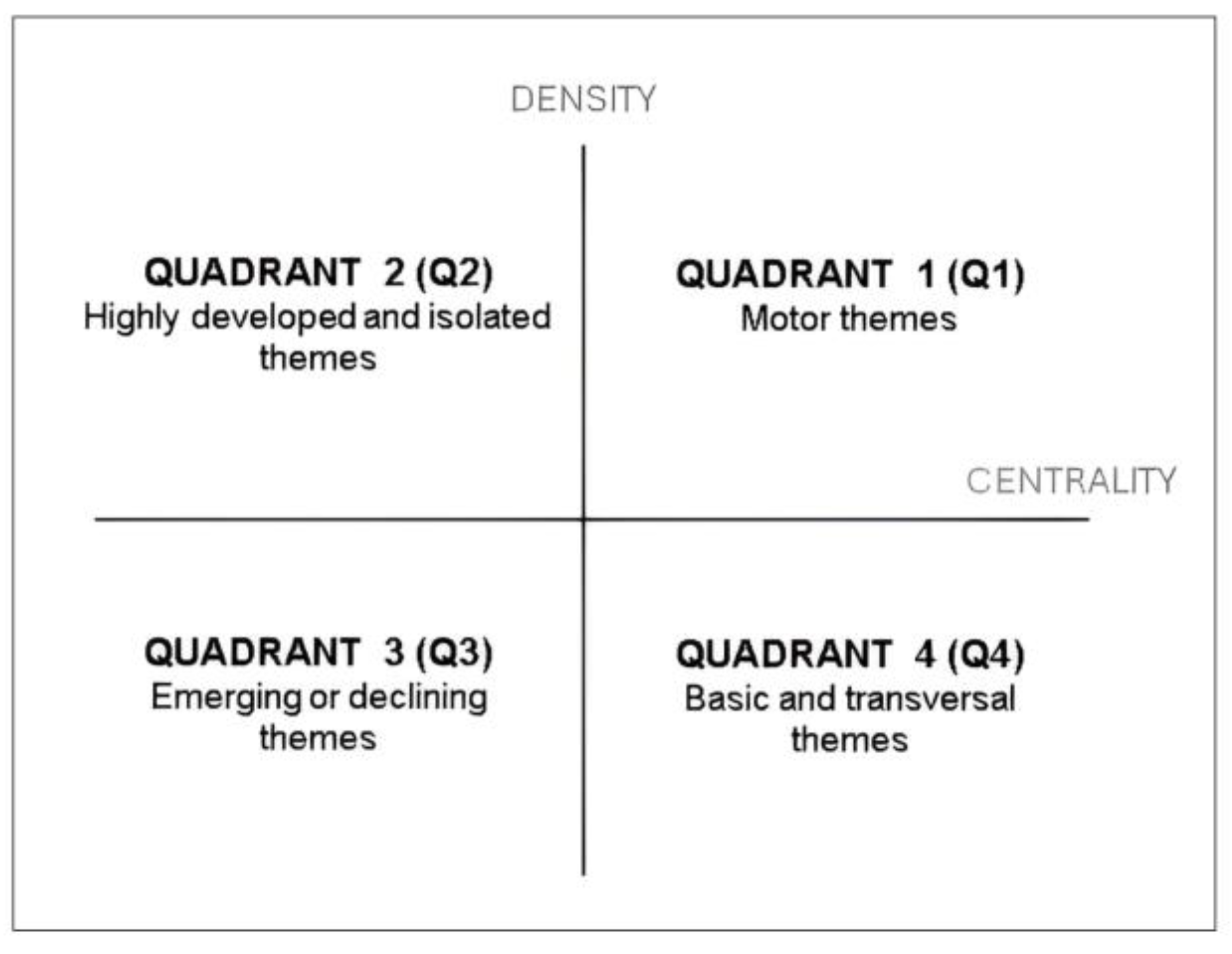
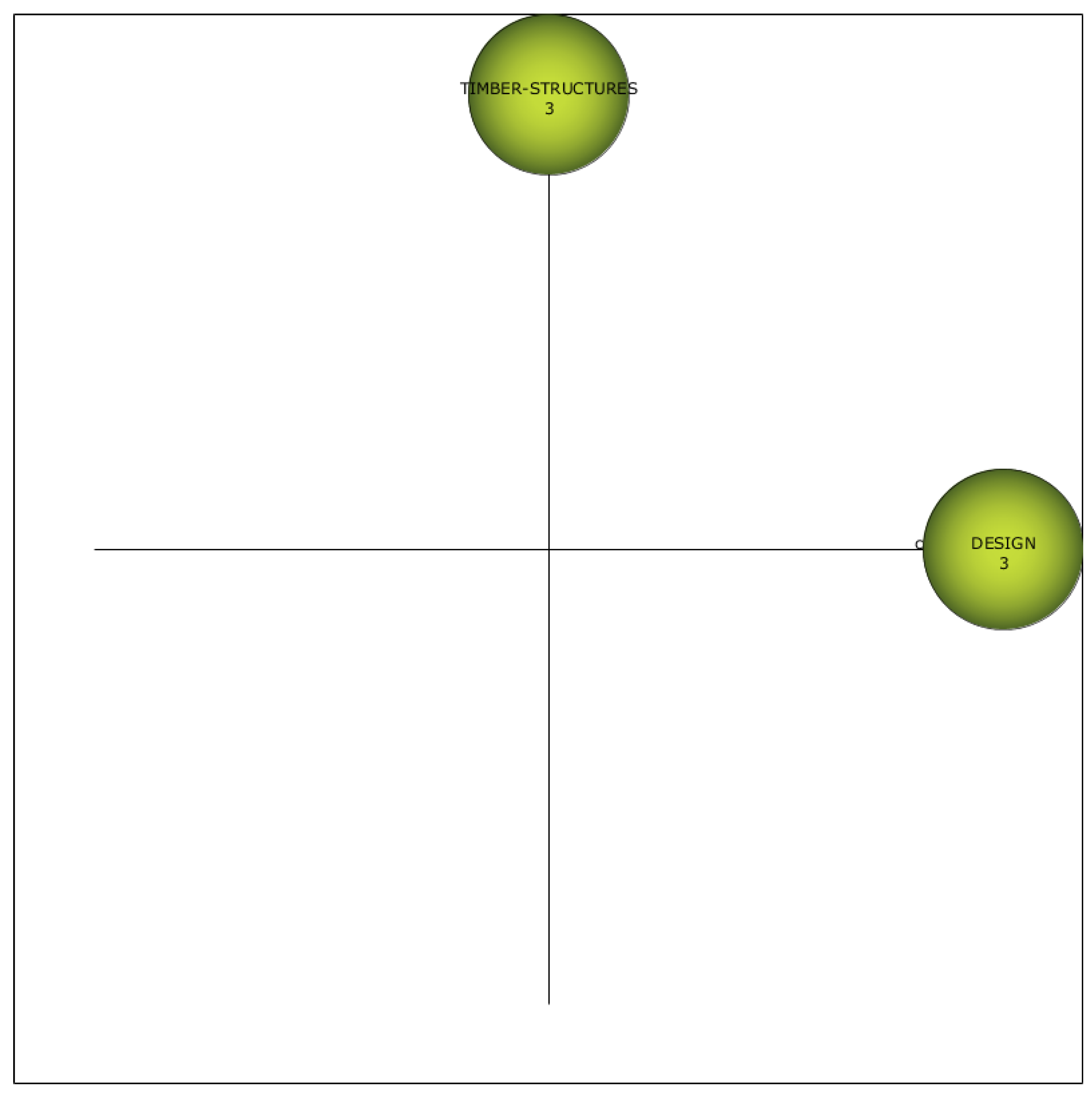
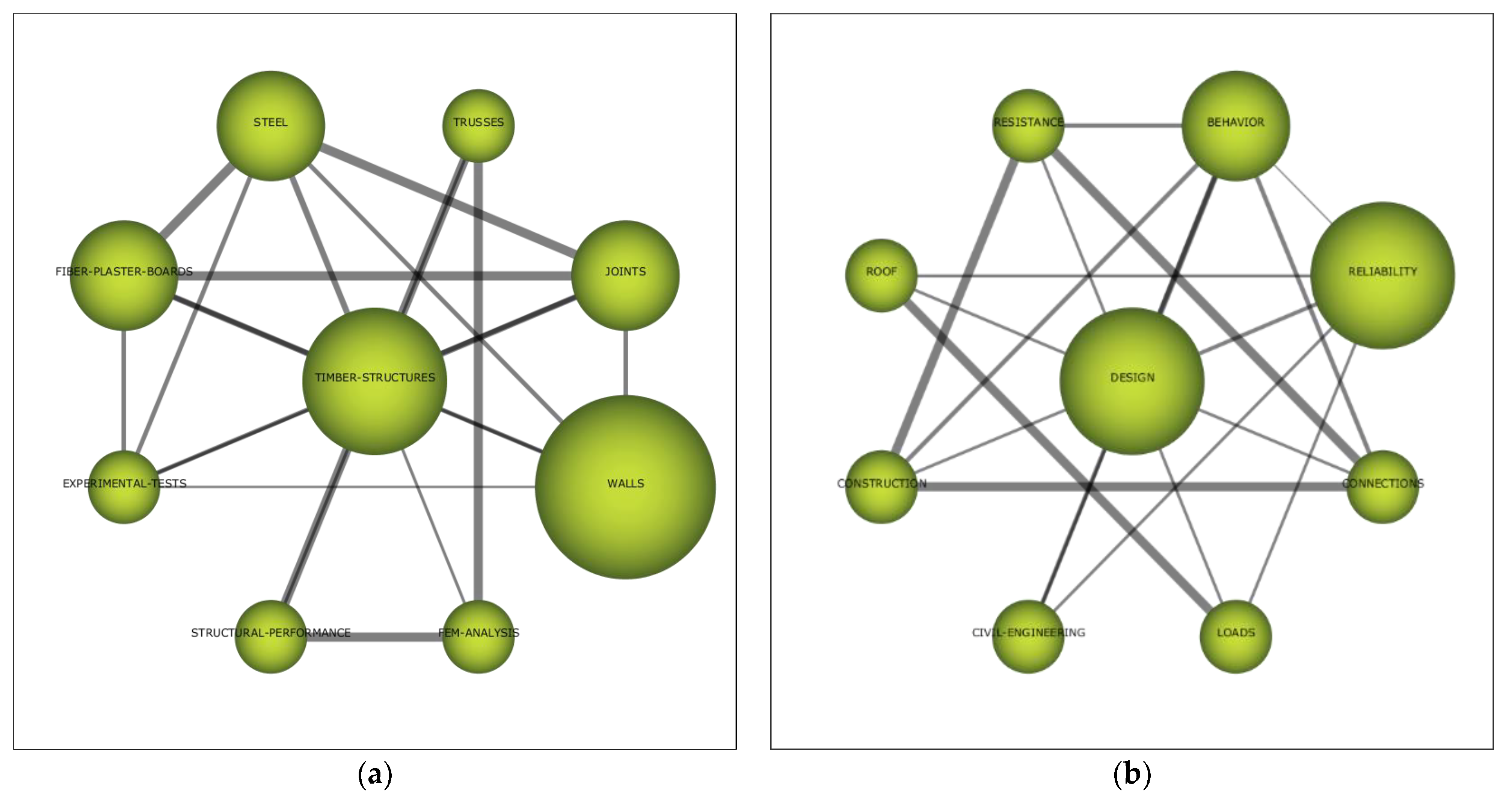
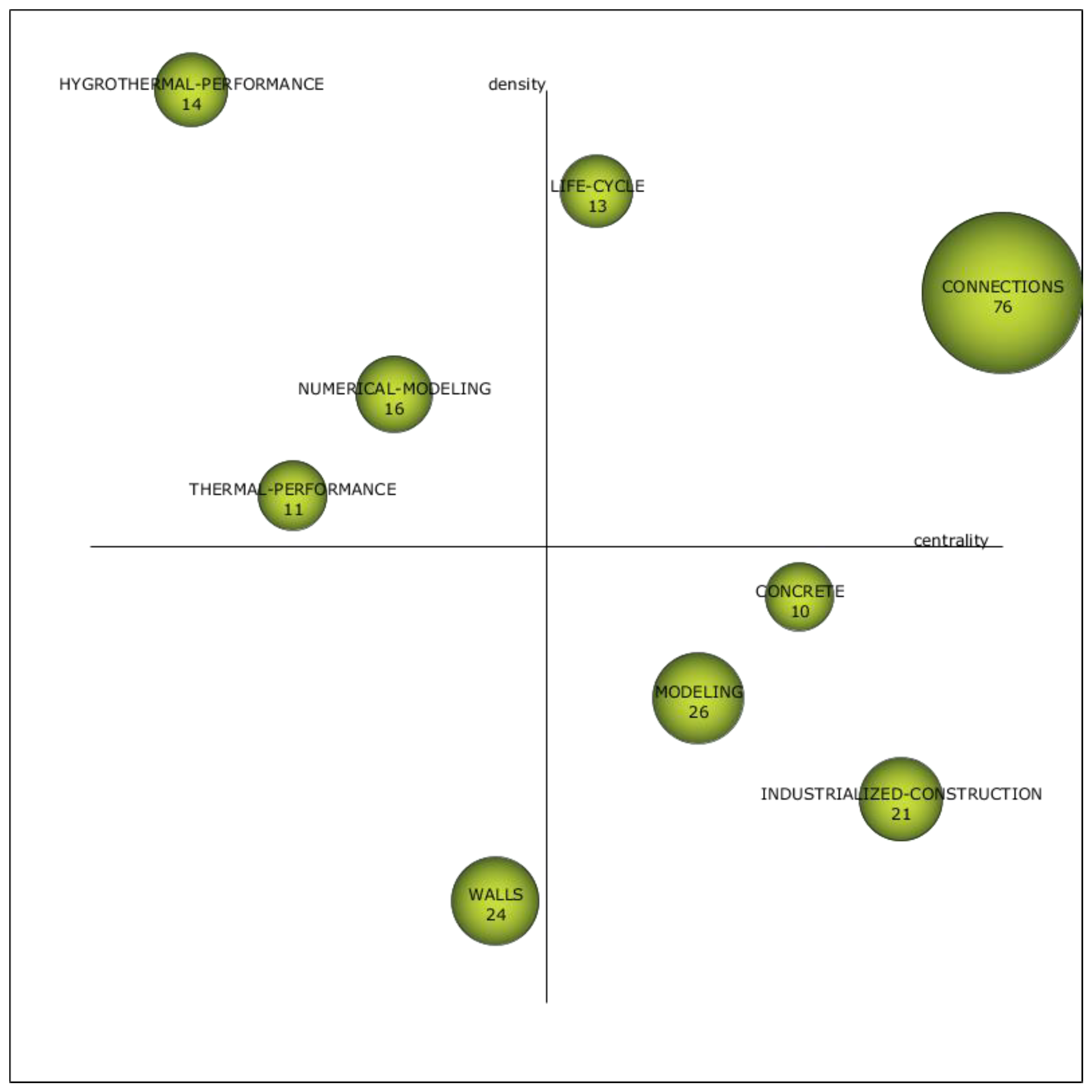
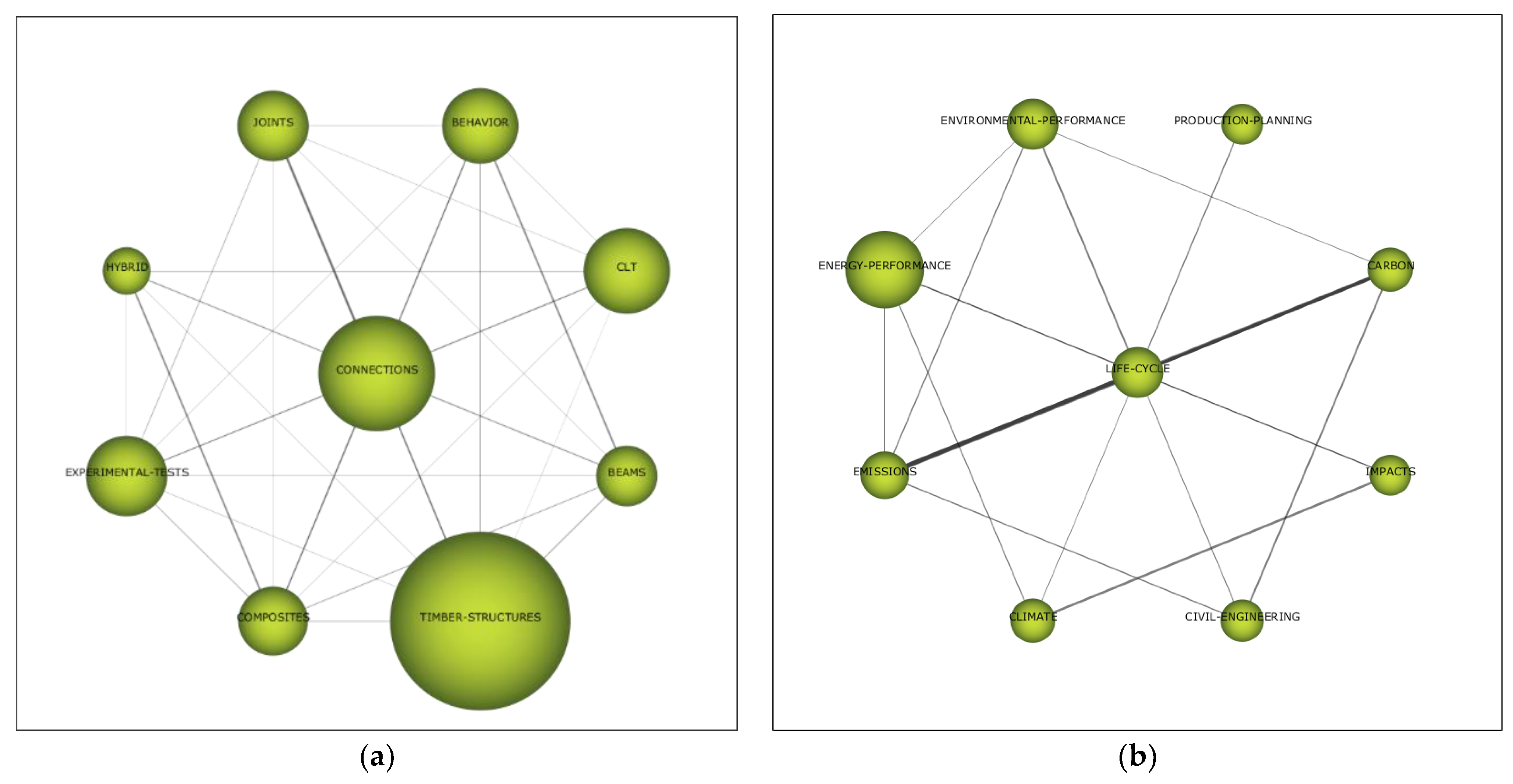
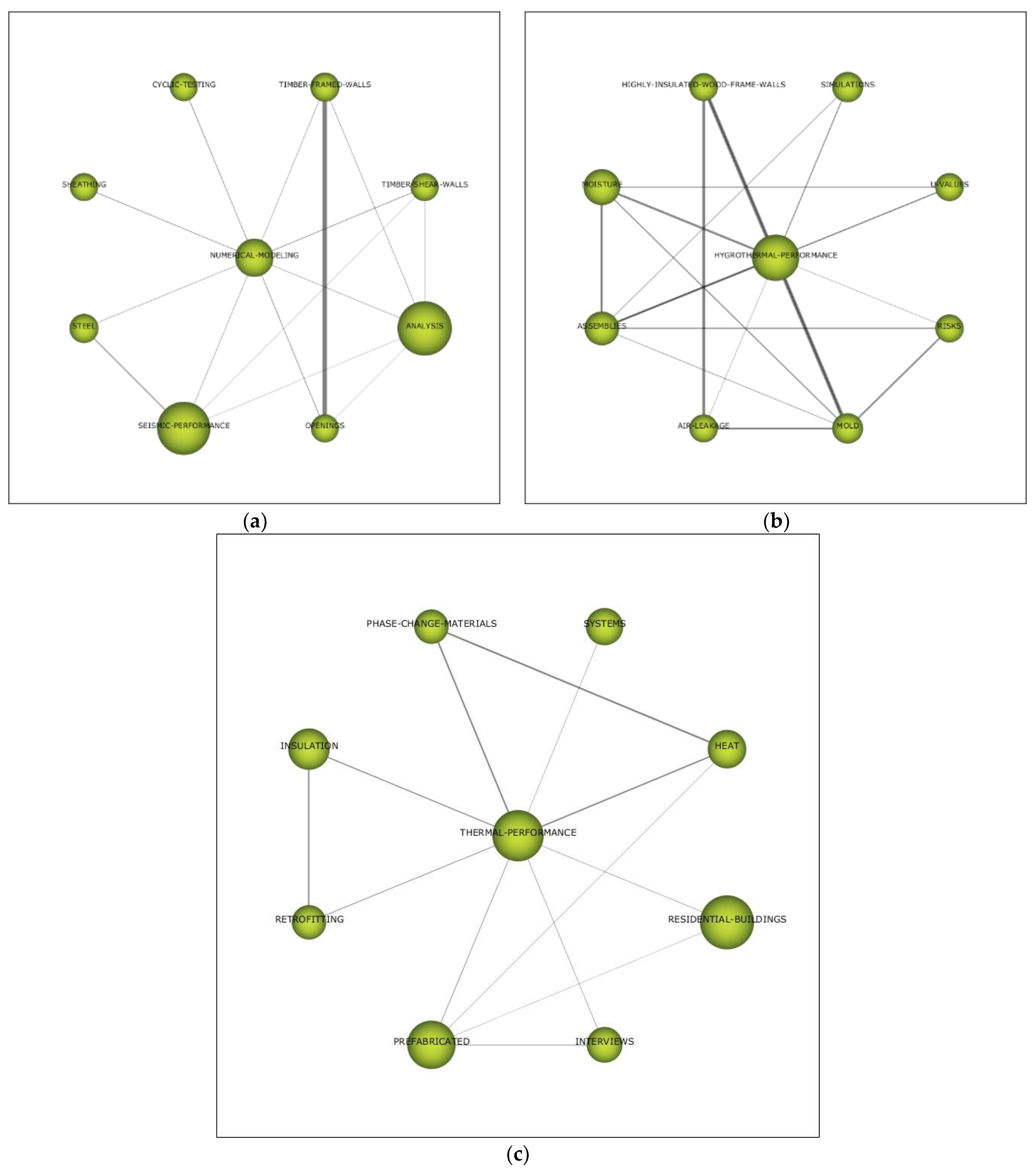
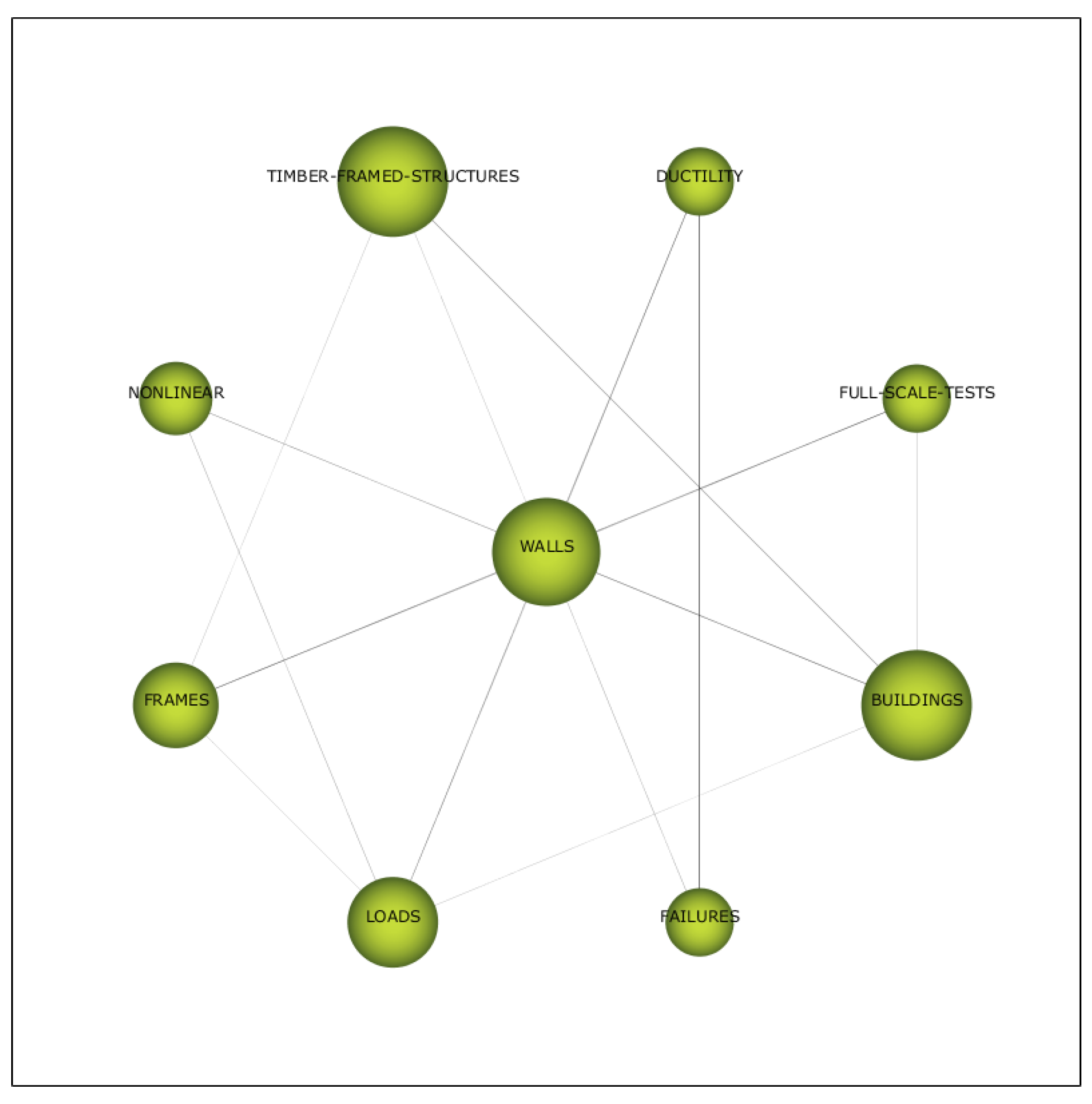


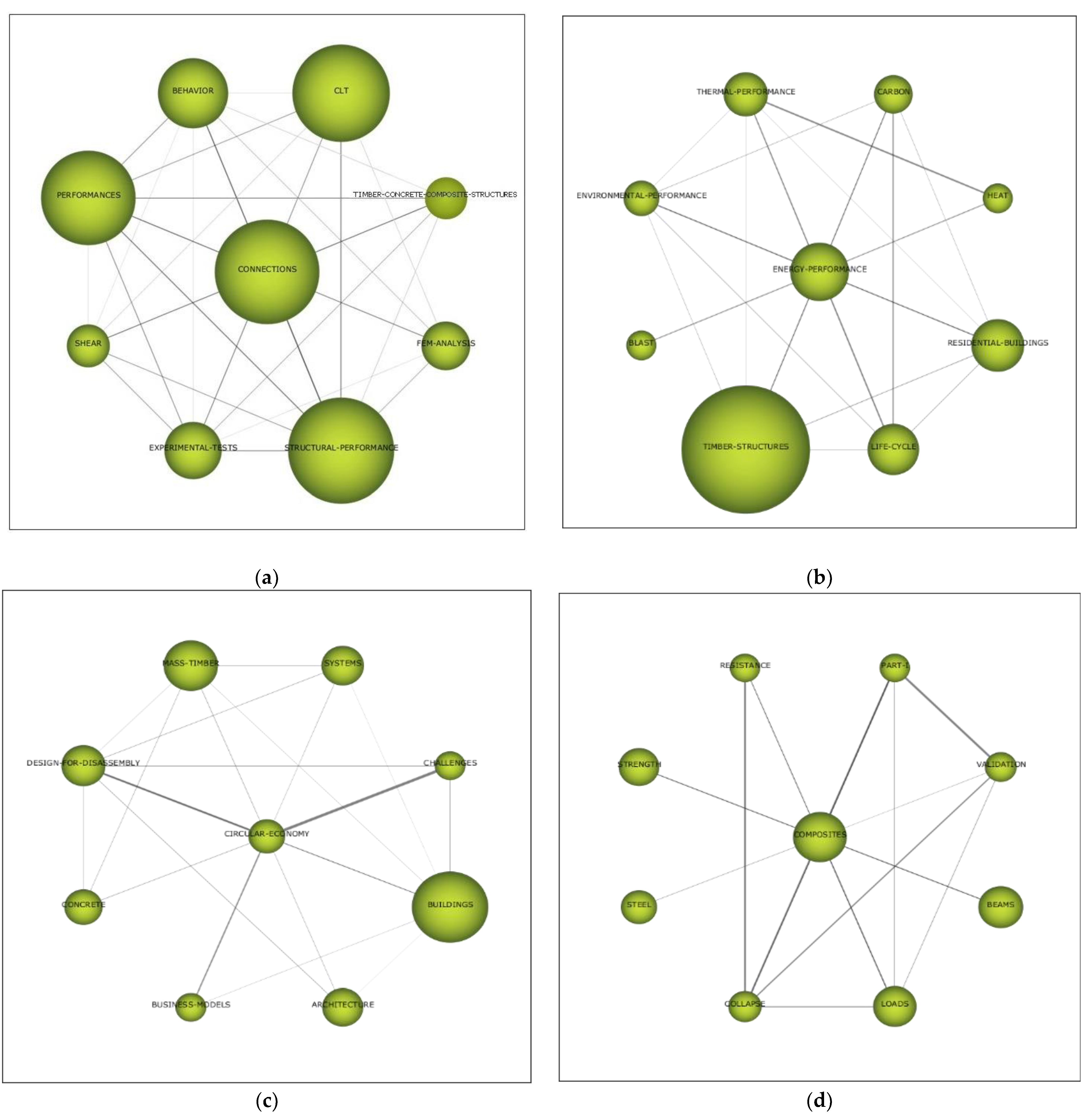
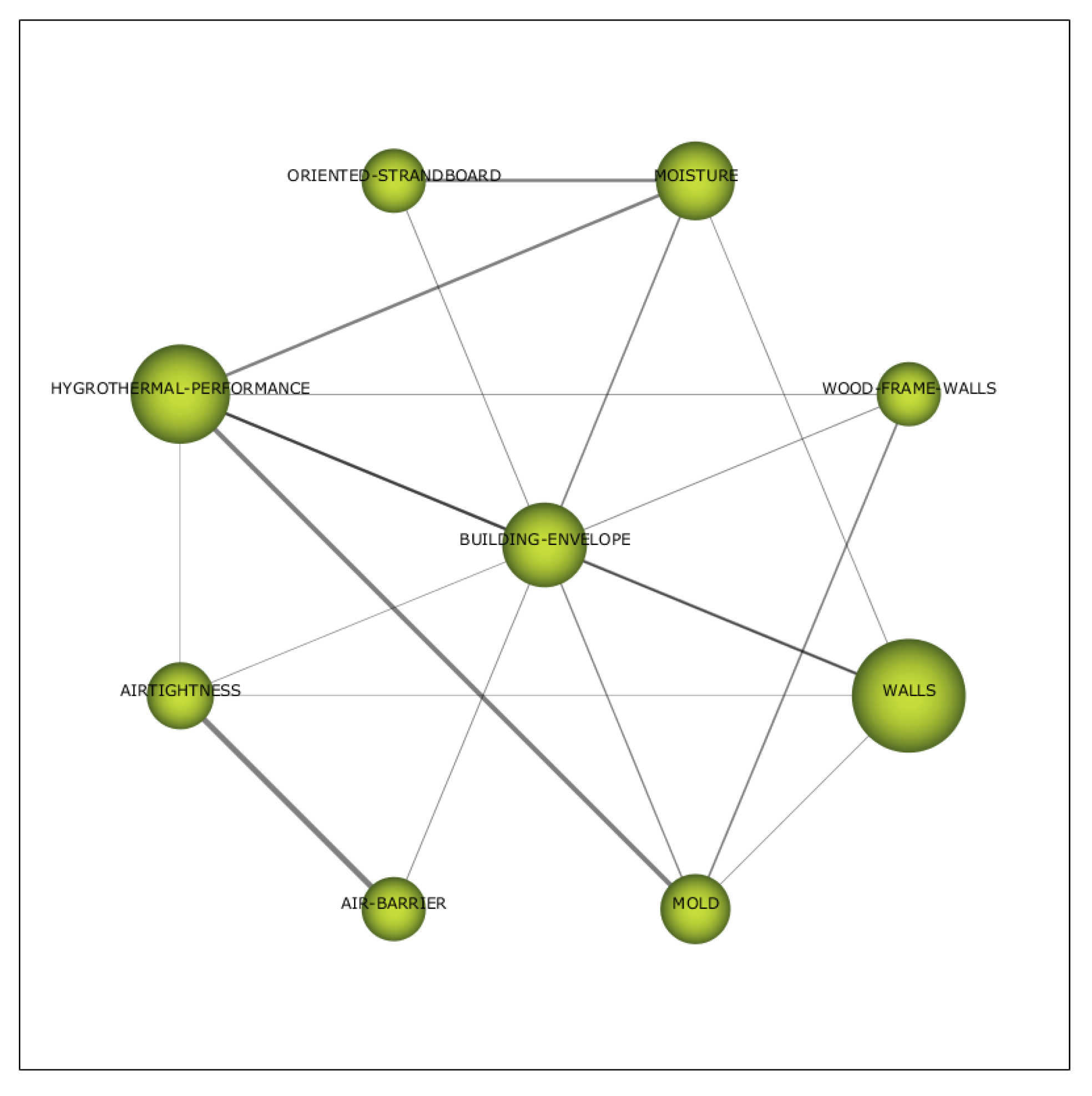
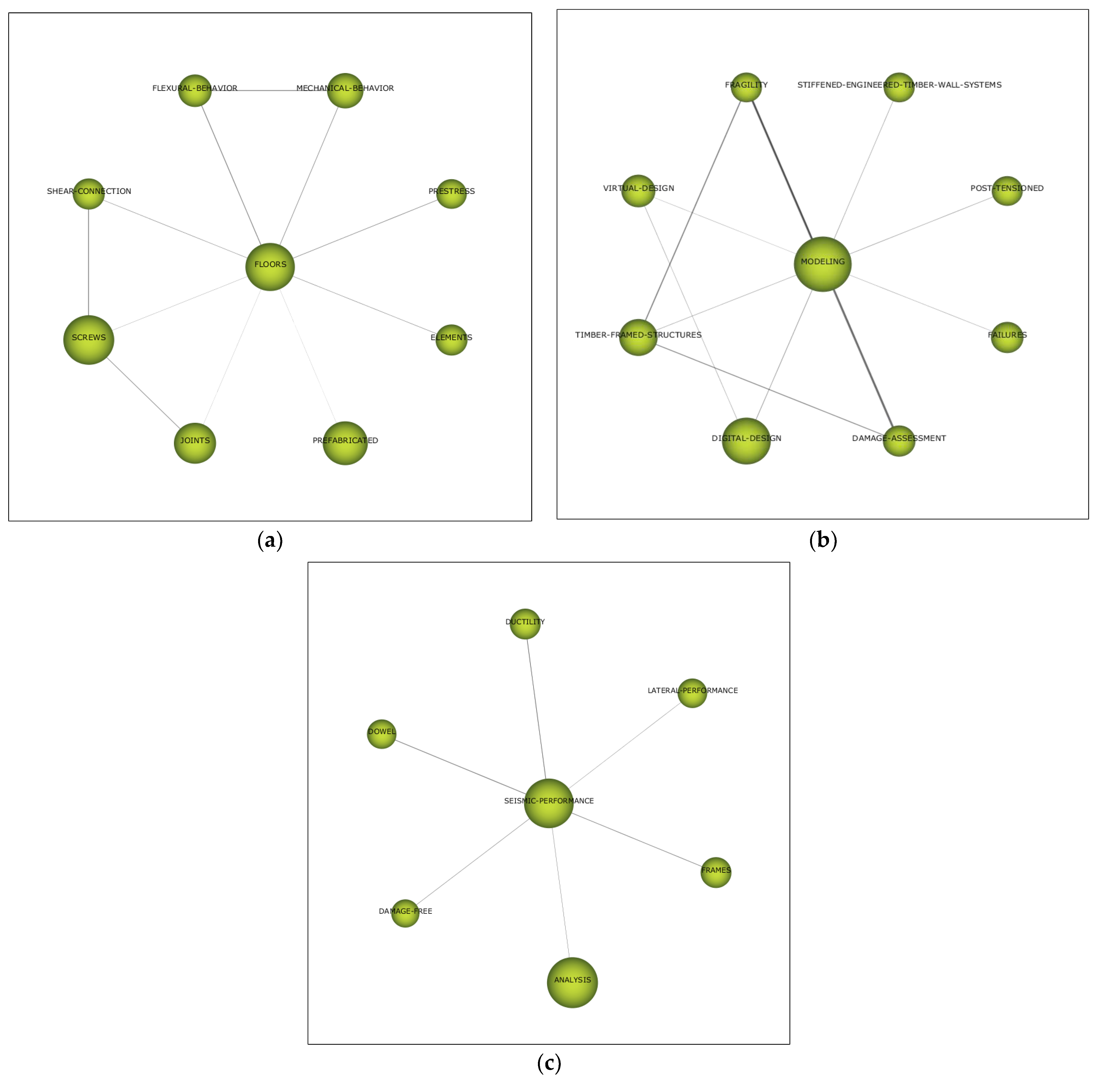
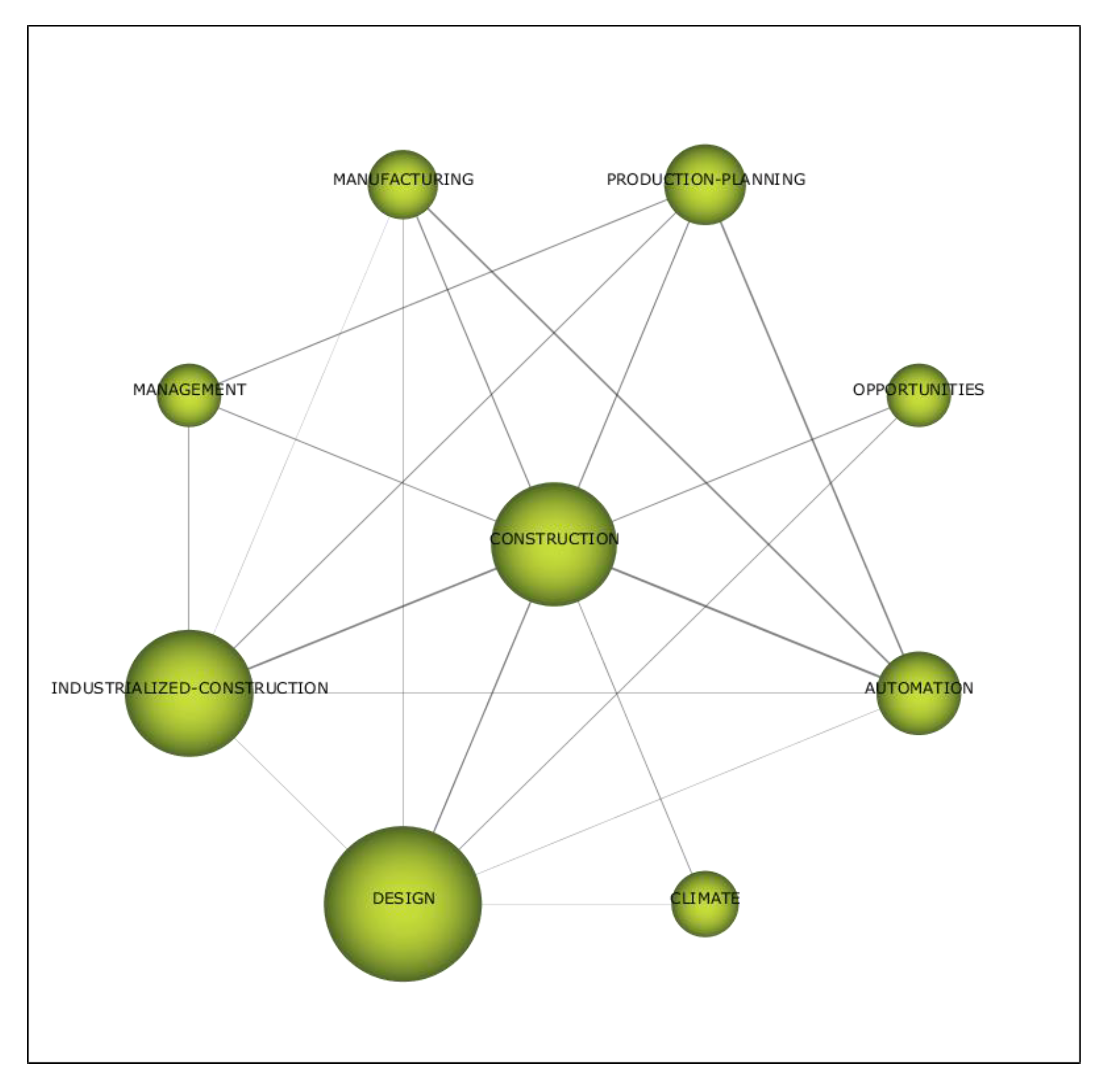

| Theme 1 | Connector | Theme 2 |
|---|---|---|
| Topic: prefab* pre-fab* modular* *assembl* | AND | Title: timber* OR wood* |
| OR | ||
| Abstract: “offsite construction” “off-site construction” “offsite manufacture” “off-site manufacture” “modular building” “modular construction” “modular technology” “prefab building” “prefab construction” “pre-fab building” “pre-fab construction” “industrialized construction” “industrialized building” “panelized construction” “tilt-up construction” “volumetric construction” “prefinished construction” “preassembly building” “preassembly construction” “plug & play modular” |
| Subperiod Name | Number of Documents |
|---|---|
| 1990–2004 | 11 |
| 2005–2019 | 198 |
| 2020–2023 | 200 |
| Theme Name | Number of Documents | Number of Citations | Average of Citations | h-Index |
|---|---|---|---|---|
| TIMBER-STRUCTURES | 3 | 38 | 12.66 | 3 |
| DESIGN | 3 | 27 | 9 | 3 |
| Theme Name | Number of Documents | Number of Citations | Average of Citations | h-Index |
|---|---|---|---|---|
| CONNECTIONS | 76 | 2028 | 26.684 | 26 |
| MODELING | 26 | 521 | 20.038 | 14 |
| WALLS | 24 | 454 | 18.917 | 13 |
| INDUSTRIALIZED-CONSTRUCTION | 21 | 723 | 34.429 | 14 |
| NUMERICAL-MODELING | 16 | 215 | 13.438 | 10 |
| HYGROTHERMAL-PERFORMANCE | 14 | 339 | 24.214 | 11 |
| LIFE-CYCLE | 13 | 517 | 39.769 | 11 |
| THERMAL-PERFORMANCE | 11 | 225 | 20.455 | 9 |
| CONCRETE | 10 | 353 | 35.3 | 8 |
| Theme Name | Number of Documents | Number of Citations | Average of Citations | h-Index |
|---|---|---|---|---|
| CONNECTIONS | 80 | 518 | 6.475 | 12 |
| ENERGY-PERFORMANCE | 36 | 183 | 5.083 | 9 |
| CONSTRUCTION | 32 | 232 | 7.25 | 8 |
| BUILDING-ENVELOPE | 19 | 127 | 6.684 | 8 |
| CIRCULAR-ECONOMY | 16 | 127 | 7.938 | 7 |
| COMPOSITES | 16 | 123 | 7.688 | 7 |
| FLOORS | 14 | 84 | 6 | 5 |
| MODELING | 13 | 98 | 7.538 | 5 |
| SEISMIC-PERFORMANCE | 13 | 74 | 5.692 | 6 |
Disclaimer/Publisher’s Note: The statements, opinions and data contained in all publications are solely those of the individual author(s) and contributor(s) and not of MDPI and/or the editor(s). MDPI and/or the editor(s) disclaim responsibility for any injury to people or property resulting from any ideas, methods, instructions or products referred to in the content. |
© 2024 by the authors. Licensee MDPI, Basel, Switzerland. This article is an open access article distributed under the terms and conditions of the Creative Commons Attribution (CC BY) license (https://creativecommons.org/licenses/by/4.0/).
Share and Cite
Gutiérrez, N.; Negrão, J.; Dias, A.; Guindos, P. Bibliometric Review of Prefabricated and Modular Timber Construction from 1990 to 2023: Evolution, Trends, and Current Challenges. Sustainability 2024, 16, 2134. https://doi.org/10.3390/su16052134
Gutiérrez N, Negrão J, Dias A, Guindos P. Bibliometric Review of Prefabricated and Modular Timber Construction from 1990 to 2023: Evolution, Trends, and Current Challenges. Sustainability. 2024; 16(5):2134. https://doi.org/10.3390/su16052134
Chicago/Turabian StyleGutiérrez, Nohelia, João Negrão, Alfredo Dias, and Pablo Guindos. 2024. "Bibliometric Review of Prefabricated and Modular Timber Construction from 1990 to 2023: Evolution, Trends, and Current Challenges" Sustainability 16, no. 5: 2134. https://doi.org/10.3390/su16052134






